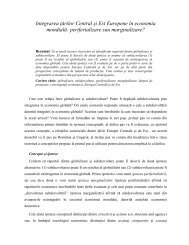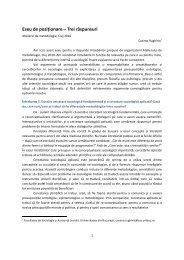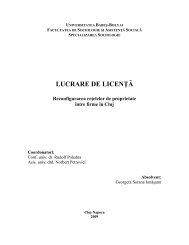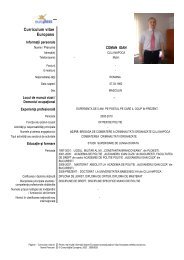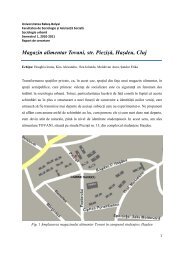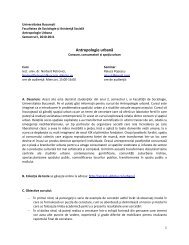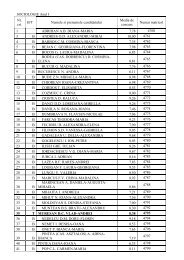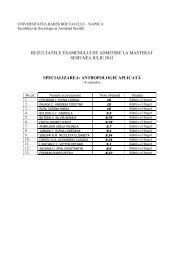Bourgeois Utopias: Visions of Suburbia*
Bourgeois Utopias: Visions of Suburbia*
Bourgeois Utopias: Visions of Suburbia*
- No tags were found...
Create successful ePaper yourself
Turn your PDF publications into a flip-book with our unique Google optimized e-Paper software.
24 robert fishmanprinciple <strong>of</strong> a city like London before 1750 was that work and residence werenaturally combined within each house. Almost all middle-class enterprises wereextensions <strong>of</strong> the family, so that it was not only the Spitalfields weaver who livedwith his loom or the grocer who lived above his shop. The banker conductedbusiness in his parlor, the merchant stored his goods in his cellar, and both housedand fed their apprentices along with their families.This intimate connection <strong>of</strong> work and residence explained the universal attraction<strong>of</strong> the wealthy bourgeoisie to the urban core. When workplace and residence arecombined, the best location for transacting one's business determined the location <strong>of</strong>one's house. In a mercantile city this location was almost invariably the mostcrowded district <strong>of</strong> the urban core.I should emphasize here that even the relatively wealthy core areas were neverupper-class neighborhoods in the modern sense. Just as the idea <strong>of</strong> a district devotedto a single function ± a residential district or a business district ± was foreign to thepremodern city, so too was a single-class district. John Strype describes the privilegedparish <strong>of</strong> St Giles in the Fields as possessing ``a mixture <strong>of</strong> rich inhabitants, to wit, <strong>of</strong>the Nobility, Gentry, and Commonality, but, withal, filled with abundance <strong>of</strong> poor.'' 5The wealthy might, at best, occupy large townhouses that fronted on the principalstreets. But the poor inevitably crowded into the narrow alleyways and courtyardsthat existed literally in the backyards <strong>of</strong> the rich. This ``medley <strong>of</strong> neighborhood,'' asStrype put it, was accepted without question. The poor were <strong>of</strong>ten servants in nearbyhouses, or workers in the multitude <strong>of</strong> small workshops found throughout the city.As one eighteenth-century writer observed,Here lives a personage <strong>of</strong> high distinction; next door a butcher with his stinkingshambles! A Tallow-chandler shall be seen from my Lord's nice Venetian window;and two or three brawny naked Curriers in their Pits shall face a fine Lady in herback Closet, and disturb her spiritual Thoughts. 6Here indeed we find the ``mixed uses'' frequently romanticized by twentieth-century``postsuburban'' planners. These mixed uses <strong>of</strong>ten had a functional basis, as whenworkshops clustered around the homes <strong>of</strong> merchants who dealt in their products.Sometimes they seem bizarre, as when a notorious ``crime district'' called Alsatiacould be found adjoining the Temple, the center <strong>of</strong> English law. 7 In any case, thebasic principles <strong>of</strong> the modern suburb had no precedents in the premodern city.The suburb as we know it, therefore, did not evolve smoothly or inevitably fromthe premodern city; still less did it evolve from those disreputable outlying districtswhich originally bore the name <strong>of</strong> ``suburbes.'' The emergence <strong>of</strong> suburbia required atotal transformation <strong>of</strong> urban values: not only a reversal in the meanings <strong>of</strong> core andperiphery, but a separation <strong>of</strong> work and family life and the creation <strong>of</strong> new forms <strong>of</strong>urban space that would be both class-segregated and wholly residential.Who then invented suburbia and why? To ask the question is to formulate a majorthesis, which is that suburbia was indeed a cultural creation, a conscious choicebased on the economic structure and cultural values <strong>of</strong> the Anglo-American bourgeoisie.Suburbanization was not the automatic fate <strong>of</strong> the middle class in the``mature industrial city'' or an inevitable response to the Industrial Revolution orthe so-called transportation revolution.
26 robert fishmantheir population and concentrating people and production within what H. G. Wellscalled ``the whirlpool cities.'' 10In 1800 only 17 percent <strong>of</strong> the English people lived in settlements larger than20,000 people. 11 Cities were then places for highly specialized forms <strong>of</strong> consumption,manufacture, and trade. The real work <strong>of</strong> the world took place in the villagesand in the countryside. By 1890, however, 72 percent <strong>of</strong> the English population livedin districts classified as ``urbanized.'' 12 In the United States in 1800 less than 4percent <strong>of</strong> the population lived in cities <strong>of</strong> 10,000 or more; by 1890 that figurehad reached 28 percent. 13 Behind these statistics lies a fundamental shift in the role<strong>of</strong> the modern city. Where premodern cities had been parasitic on the larger societies,the new industrial metropolis emerged as the most efficient and productive site forthe most characteristic modern industries. 14As such ``whirlpool cities'' as London, Manchester, and New York came todominate the world economy, their attraction grew ever more powerful. In thesecenters <strong>of</strong> exchange and information, crowding seemed to work; in other words,intense congestion led not to chaos and decline but to further expansion. In thenineteenth century the expression ``urban crisis'' referred to the explosive growth <strong>of</strong>the great cities, and to horrified critics it seemed that almost the whole population <strong>of</strong>modern nations would soon be sucked into the already crowded urban centers. 15Inevitably, these whirlpool cities had to expand physically, to break the barriers <strong>of</strong>size that had always constrained urban growth. The only question was if they wouldgrow in the traditional manner, with the wealthy massed at the core and the poorpushed ever farther into the periphery; or if the middle class would use their wealthand resources to seize the unspoiled land at the urban fringe for their suburban``bourgeois utopia,'' forcing the working class into an intermediate ``factory zone''sandwiched between the central business district and the suburbs.Broadly speaking, continental and Latin American cities opted for the traditionalstructure, while British and North American cities followed the path <strong>of</strong> middle-classsuburbanization. This distinction, still fundamental in so many <strong>of</strong> the world's greatcities, had nothing to do with the supposed backwardness <strong>of</strong> continental cities ascompared to their Anglo-American counterparts. Paris in the nineteenth centurybecame far more intensively industrialized than London, and the French capitaldeveloped a network <strong>of</strong> omnibuses, streetcars, and railroads that matched thetransportation facilities in any English or American city. Yet the Parisian middleclass remained loyal to the central city; the transportation system in Paris was usedto move Parisian industry and its workers to the suburbs, and every further advancein transportation and industry has meant moving factories and the working classeven farther from the city while the Parisian middle class has solidified its hold onthe urban core.However ``objective'' the ``industrial city'' might appear in diagrams from theChicago School <strong>of</strong> sociology, its form rests ultimately on the values and choices <strong>of</strong>the powerful groups within the city. The decision <strong>of</strong> the bourgeoisie in Manchesterand the other early industrial cities in the 1840s to suburbanize created the basicstructure <strong>of</strong> the Anglo-American industrial city, while the decision <strong>of</strong> the comparablegroup in Paris <strong>of</strong> the 1850s and 1860s (aided by considerable governmental aid andintervention) to live in apartment houses in the center created the modern continental-stylecity.
ourgeois utopias: visions <strong>of</strong> suburbia 27In both cases the key actor was that elite <strong>of</strong> the middle class, the bourgeoisie. By``bourgeoisie'' I mean that part <strong>of</strong> the middle class which through its capital or itspr<strong>of</strong>essional standing has attained an income level equal to the landed gentry, butwhose daily work in urban <strong>of</strong>fices ties it to middle-class style <strong>of</strong> life. Their personalresources permit them to create new patterns <strong>of</strong> living, while the values they sharewith the rest <strong>of</strong> the middle class make them the model for eventual emulation by theless prosperous. The history <strong>of</strong> suburbia must therefore be a cultural and socialhistory <strong>of</strong> the Anglo-American bourgeoisie. They are the pioneers whose collectivestyle and choices define the nature <strong>of</strong> suburbia for their era.For these English and American bourgeois pioneers, the ``frontier'' was inevitablythe urban periphery, with its relatively cheap, undeveloped land. In continental citiesmassive governmental intervention ± the nineteenth-century versions <strong>of</strong> urban renewal± opened the possibility <strong>of</strong> reshaping the urban core for bourgeois uses. InEngland and the United States, laissez-faire urban economics turned the core into atangle <strong>of</strong> competing uses. Only the periphery was sufficiently undefined to permitinnovation. Indeed, the fate <strong>of</strong> the periphery was ultimately decisive in defining thewhole structure <strong>of</strong> the Anglo-American city. In this Darwinian struggle for urbanspace, the bourgeoisie sought not only land for their commercial and industrialenterprises but also land for their dreams: their visions <strong>of</strong> the ideal middle-classhome. These dreams are now deep in the structure <strong>of</strong> the twentieth-century city.The history <strong>of</strong> suburbia is thus a history <strong>of</strong> a vision the bourgeois utopia ± whichhas left its mark on thousands <strong>of</strong> individual suburbs, each with its own distinctivehistory. But I believe that all these communities can be linked to a single suburbantradition <strong>of</strong> architectural and social history. In attempting to outline the principalstages in the evolution <strong>of</strong> this tradition, I have been forced to depart from the usualmethod <strong>of</strong> suburban history, which is to examine one community over time. Nosingle suburb adequately represents all the stages <strong>of</strong> suburban evolution, so I haveselected a series <strong>of</strong> communities that seem best to embody the suburban idea at eachcrucial point <strong>of</strong> innovation.These suburbs are not typical <strong>of</strong> their time but rather exemplary. Built rapidly inperiods <strong>of</strong> unusual growth and prosperity, they incorporate in their design a creativeresponse to contemporary changes in the structure and economy <strong>of</strong> modern cities.Unconstrained by previous building, responding to new social and cultural forces,these communities are truly ``<strong>of</strong> their time.'' Through a series <strong>of</strong> <strong>of</strong>ten uncoordinateddecisions by developers, builders, and individuals, a new style arises, which is thencopied in hundreds <strong>of</strong> other suburbs. These exemplary suburbs create the image that,at any particular time, defines the suburban tradition. This image then becomes anactive force in urban history, shaping subsequent decisions by speculators and homebuyers that transform the urban landscape.The first models for this process ± and consequently the inevitable starting point forthis book ± were those earliest <strong>of</strong> modern suburbs which took shape on the outskirts<strong>of</strong> London in the second half <strong>of</strong> the eighteenth century. They not only defined theessential suburban image for all subsequent development but, in their strict segregation<strong>of</strong> class and function, they also implied a new structure for the modern city.These implications were first worked out in practice not in London itself but in theearly nineteenth-century industrial cities <strong>of</strong> northern England. The suburbs <strong>of</strong> Manchester,which form the second group <strong>of</strong> exemplary suburbs, were the necessary
28 robert fishmancatalyst in reshaping the whole structure <strong>of</strong> the modern industrial city. For the firsttime one sees a middle class that is wholly suburbanized; and, as necessary correlates,a central business district devoid <strong>of</strong> residents and a crowded, smoky factoryzone between the central business district and suburbia. Frenzied land speculation,bitter class conflict, and the alluring image <strong>of</strong> the bourgeois utopia combined torestructure the basic components <strong>of</strong> the city.By the 1840s Manchester had established a model for middle-class suburbanizationthat was to endure fundamentally unchanged for a century. In the 1850s and1860s this suburban model established itself outside the rapidly growing cities <strong>of</strong> theUnited States but was decisively rejected in France. There, as we have seen, thebourgeoisie maintained their hold on the urban core. This dichotomy creates animportant problem for any history <strong>of</strong> suburbia: why did this bourgeois utopia takehold only among the ``Anglo-Saxon'' bourgeoisie, when the equally bourgeoisFrench followed a very different vision?The answer hinges both on long-term differences between French and Anglo-American images <strong>of</strong> the city and on the specifics <strong>of</strong> EugeÁne-Georges Haussmann'smassive rebuilding <strong>of</strong> Paris. In any case, the great apartment houses along the newboulevards <strong>of</strong> Paris ± as well as their counterparts in Vienna's Ringstrasse ± created apowerful counterimage that shaped the continental city into a structure diametricallyopposed to that <strong>of</strong> the English city. At the same time, and for equally strongcultural and economic reasons, the American middle class adopted the Englishmodel <strong>of</strong> bourgeois suburbanization so decisively that ever since Americans havebeen convinced that it was they who invented suburbia.Indeed, after 1870 the site <strong>of</strong> the ``exemplary'' suburb shifted decisively to theUnited States. It happened not because <strong>of</strong> any loss <strong>of</strong> enthusiasm for the suburbanideal in England. The slowing <strong>of</strong> the British economy, first apparent in the latenineteenth century, combined with the explosive growth <strong>of</strong> the American industrialcity, meant that English suburbs were more constrained by the past, while the UnitedStates was forced to innovate.The suburbs that arose outside the American industrial cities at the end <strong>of</strong> thenineteenth century were the classic embodiments <strong>of</strong> the whole history <strong>of</strong> suburbia.They not only summed up the design tradition now more than a century old, butthey provided the model that all subsequent suburbs have attempted to imitate.Structurally, these suburbs were at once separate from the industrial city and yet,through the streetcar and the steam railroad, easily accessible to it. Socially, theyhoused a powerful and self-conscious bourgeoisie that combined the old businessand pr<strong>of</strong>essional elite with the ``new middle class'' anxious to establish its separatenessfrom the immigrant cities. In design, the substantial houses set in open, treeshadedlots summed up that blend <strong>of</strong> property, union with nature, and family lifewhich defines the suburban tradition. I have chosen the suburbs <strong>of</strong> Philadelphia toexemplify this era ± though the suburbs <strong>of</strong> Boston, New York, Baltimore, St Louis,and especially Chicago would have served just as well.If there is a single theme that differentiates the history <strong>of</strong> twentieth-centurysuburbia from its nineteenth-century antecedents, it is the attempt to secure for thewhole middle class (and even for the working class as well) the benefits <strong>of</strong> suburbia,which in the classic nineteenth-century suburb has been restricted to the bourgeoiselite alone. Inevitably, this attempt was to change the basic nature both <strong>of</strong> suburbia
ourgeois utopias: visions <strong>of</strong> suburbia 29and <strong>of</strong> the larger city. For how can a form based on the principle <strong>of</strong> exclusion includeeveryone?This paradox is exemplified in the history <strong>of</strong> Los Angeles, the suburban metropolis<strong>of</strong> the twentieth century. From its first building boom in the late nineteenthcentury, Los Angeles has been shaped by the promise <strong>of</strong> a suburban home for all. Theautomobile and the highway when they came were no more than new tools toachieve a suburban vision that had its origins in the streetcar era. But as populationspread along the streetcar lines and the highways, the ``suburbs'' <strong>of</strong> Los Angelesbegan to lose contact with the central city, which so diminished in importance thateven the new highways bypassed it. In the 1920s, a new urban form evolved in whichthe industries, specialized shopping, and <strong>of</strong>fices once concentrated in the urban corespread over the whole region. By the 1930s Los Angeles had become a sprawlingmetropolitan region, the basic unit <strong>of</strong> which was the decentralized suburb.This creation <strong>of</strong> a suburban metropolis signaled a fundamental shift in therelationship <strong>of</strong> the urban core and its periphery, with implications extending farbeyond Los Angeles. As we have seen, the suburb emerged during the era <strong>of</strong> urbanconcentration, when the limitations <strong>of</strong> communications and transportation combinedto draw people and production into the crowded core. By the 1920s aninterrelated technology <strong>of</strong> decentralization ± <strong>of</strong> which the automobile was onlyone element ± had begun to operate, which inexorably loosened the ties that oncebound the urban functions <strong>of</strong> society to tightly defined cores. As the most importanturban institutions spread out over the landscape, the suburb became part <strong>of</strong> acomplex ``outer city,'' which now included jobs as well as residences.Increasingly independent <strong>of</strong> the urban core, the suburb since 1945 has lost itstraditional meaning and function as a satellite <strong>of</strong> the central city. Where peripheralcommunities had once excluded industry and large-scale commerce, the suburb nowbecomes the heartland <strong>of</strong> the most rapidly expanding elements <strong>of</strong> the late twentiethcenturyeconomy. The basic concept <strong>of</strong> the suburb as a privileged zone between cityand country no longer fits the realities <strong>of</strong> a posturban era in which high-tech researchcenters sit in the midst <strong>of</strong> farmland and grass grows on abandoned factory sites inthe core. As both core and periphery are swallowed up in seemingly endless multicenteredregions, where can one find suburbia?This problem forms the heart <strong>of</strong> my concluding chapter in the book from which thisessay is drawn, ``Beyond Suburbia: The rise <strong>of</strong> the Technoburb.'' Kenneth Jackson inhis definitive history <strong>of</strong> American suburbanization, Crabgrass Frontier, interpretspost-World War II peripheral development as ``the suburbanization <strong>of</strong> the UnitedStates,'' the culmination <strong>of</strong> the nineteenth-century and early twentieth-century suburbantradition. 16 I see this development as something very different, the end <strong>of</strong> suburbiain its traditional sense and the creation <strong>of</strong> a new kind <strong>of</strong> decentralized city.Without anyone planning or foreseeing it, the simultaneous movement <strong>of</strong> housing,industry, and commercial development to the outskirts has created perimeter citiesthat are functionally independent <strong>of</strong> the urban core. In complete contrast to theresidential or industrial suburbs <strong>of</strong> the past, these new cities contain along theirsuperhighways all the specialized functions <strong>of</strong> a great metropolis ± industry, shoppingmalls, hospitals, universities, cultural centers, and parks. With its highways andadvanced communications technology, the new perimeter city can generate urbandiversity without urban concentration.
30 robert fishmanTo distinguish the new perimeter city from the traditional suburban bedroomcommunity, I propose to identify it by the neologism ``technoburb.'' For the realbasis <strong>of</strong> the new city is the invisible web <strong>of</strong> advanced technology and telecommunicationsthat has been substituted for the face-to-face contact and physical movement<strong>of</strong> older cities. Inevitably, the technoburb has become the favored location for thosetechnologically advanced industries which have made the new city possible. If, asFernand Braudel has said, the city is a transformer, intensifying the pace <strong>of</strong> change,then the American transformer has moved from the urban core to the perimeter. 17If the technoburb has lost its dependence on the older urban cores, it now exists ina multicentered region defined by superhighways, the growth corridors <strong>of</strong> whichcould extend more than a hundred miles. These regions, which (if the reader willpardon another neologism) I call techno-cities, mean the end <strong>of</strong> the whirlpool effectthat had drawn people to great cities and their suburbs. Instead, urban functionsdisperse across a decentralized landscape that is neither urban nor rural nor suburbanin the traditional sense. With the rise <strong>of</strong> the technoburb, the history <strong>of</strong> suburbiacomes to an end.NOTES1 CeÂsar Daly. L'Architecture priveÂe au XIX e sieÁcle sous NapoleÂon III, 2 vols in 3 (Paris:Morel, 1864), 1:20; my translation.2 Ge<strong>of</strong>frey Chaucer. Canterbury Tales, Canon's Yeoman's Tale, lines 557±60:In the suburbes <strong>of</strong> town ...Lurkynge in hernes and in lanes blynde,Whereas thise robbours and thise theves by kyndeHolden hirpryvee fereful residence ...3 Oxford English Dictionary, s.v. ``suburb.''4 Quoted in Pat Rogers. Grub Street: Studies in a Subculture (London: Methuen, 1972),26.5 John Strype in John Stow. A Survey <strong>of</strong> the Cities <strong>of</strong> London and Westminster and theBorough <strong>of</strong> Southwark [orig. ed. 1598], ``corrected, improved, and very much enlarged inthe year 1720'' by John Strype, 6th edn, 2 vols (London: Innys & Richardson, 1754±55),ii, 76.6 Anonymous article in Old England (London), 2 July 1748.7 Encyclopaedia Britannica, 11th edn, s.v. ``London.''8 Lawrence J. Stone. The Family, Sex and Marriage in England, 1500±1800 (New York:Harper & Row, 1977), part 4.9 Frederick Law Olmsted. Preliminary Report upon the Proposed Suburban Village atRiverside, near Chicago (New York, 1868); reprinted in S. B. Sutton (ed.). CivilizingAmerican Cities: A Selection <strong>of</strong> Frederick Law Olmsted's Writings on City Landscapes(Cambridge, MA: MIT Press, 1971), 293.10 H. G. Wells. The Probable Diffusion <strong>of</strong> Great Cities (1900). In Anticipations and OtherPapers, vol. 4 <strong>of</strong> The Works <strong>of</strong> H. G. Wells (New York: Scribner's, 1924), 39. Wellshimself attributes the phrase to George Gissing.11 Adna F. Weber. The Growth <strong>of</strong> Cities in the Nineteenth Century, rev. edn (Ithaca, N. Y.:Cornell University Press, 1963; orig. edn. 1899), 47.12 Ibid.
ourgeois utopias: visions <strong>of</strong> suburbia 3113 Ibid., 39.14 For the best scholarly analysis <strong>of</strong> the city's changing role over time, see Paul M. Hohenbergand Lynn H. Lees. The Making <strong>of</strong> Urban Europe, 1000±1950 (Cambridge, MA:Harvard University Press, 1985).15 Andrew Lees. Cities Perceived: Urban Society in European and American Thought,1820±1940 (New York: Columbia University Press, 1985), 136±88. As Lees emphasizes,these negative views were balanced by more positive evaluations <strong>of</strong> the impact <strong>of</strong>urbanization.16 Kenneth T. Jackson. Crabgrass Frontier: The Suburbanization <strong>of</strong> the United States (NewYork: Oxford University Press, 1985).17 Fernand Braudel. Capitalism and Material Life, 1400±1800, trans. Miriam Kochan(New York: Harper & Row, 1975), 373, for the concept <strong>of</strong> the city as ``transformer.''



